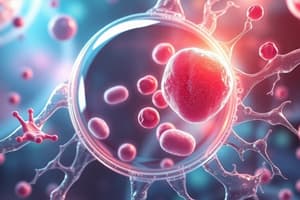Podcast
Questions and Answers
What is the primary function of lysosomes?
What is the primary function of lysosomes?
- To aid in DNA replication
- To store energy in the form of lipids
- To break down cellular waste and toxic substances (correct)
- To synthesize proteins
What is the main role of peroxisomes in the cell?
What is the main role of peroxisomes in the cell?
- To store genetic information in the form of DNA
- To break down harmful substances and utilize fats as an energy source (correct)
- To produce energy through cellular respiration
- To facilitate cell-to-cell communication
What is the primary function of the cytoplasm in a eukaryotic cell?
What is the primary function of the cytoplasm in a eukaryotic cell?
- To provide a structural framework for the cell
- To act as a barrier between the cell and its external environment
- To serve as the medium for chemical reactions and provide a platform for organelle operations (correct)
- To store genetic information
What is the primary role of the cell membrane?
What is the primary role of the cell membrane?
What is the primary function of the cell nucleus?
What is the primary function of the cell nucleus?
What is the primary purpose of cellular respiration in a eukaryotic cell?
What is the primary purpose of cellular respiration in a eukaryotic cell?
What is the primary function of mitochondria?
What is the primary function of mitochondria?
Which organelle is described as the 'post office' of the cell?
Which organelle is described as the 'post office' of the cell?
What is the primary function of the endoplasmic reticulum (ER)?
What is the primary function of the endoplasmic reticulum (ER)?
In which part of the cell does cellular respiration occur?
In which part of the cell does cellular respiration occur?
What is the main function of the cell membrane?
What is the main function of the cell membrane?
Where is the genetic material of the cell stored?
Where is the genetic material of the cell stored?
Flashcards are hidden until you start studying
Study Notes
Cell Structure and Function: An In-Depth Look at Organelles, Cytoplasm, Nucleus, Respiration, and Membrane
Introduction
In the realm of biological functioning, cells stand as the fundamental units of life. These tiny structures are marvels of molecular engineering, consisting of tightly organized assemblages of macromolecules. They exhibit a range of different sizes, shapes, and functions, designed to meet the diverse requirements of various life forms. Central to this exposition is an exploration of the central aspects of cell architecture, with a focus on organelles, cytoplasm, nucleus, cellular respiration, and cell membrane.
Organelles
At the heart of cellular organization lies the presence of specialized organelles. These "mini-organs," suspended in the cytoplasm, perform specific tasks vital to the cell's overall operation. Notable examples include:
- Mitochondria: These double-membraned organelles are the powerhouses of the cell, producing energy through cellular respiration.
- Endoplasmic Reticulum (ER): An extensive network of tubules and interconnected flattened sacs that assist in protein synthesis and lipid production.
- Golgi Apparatus: Often referred to as the 'post office' of the cell, Golgi bodies facilitate modifications and sorting of proteins before they are transported out of the cell.
- Lysosomes: Enclosed in a single membrane, these organelles break down cellular waste products and toxic substances, playing a key role in recycling and maintaining homeostasis.
- Peroxisomes: Vesicle-like packets containing specialized enzymes that aid in detoxifying cells by breaking down harmful substances and utilizing fats as an energy source.
These organelles are not only essential for individual cellular functions but also contribute to the overall coherence of complex multicellular structures.
Cytoplasm
The cytoplasm is a gelatinous fluid that fills the space between the nucleus and cell membrane within eukaryotic cells. It serves as the medium for chemical reactions, providing a platform upon which other organelles can operate. Major classes of intracellular organic molecules exist within the cytoplasm, including nucleic acids, proteins, carbohydrates, and lipids. These elements are crucial for various cellular processes such as DNA replication, protein synthesis, energy storage, and more.
Cell Membrane
The cell membrane, also known as the plasma membrane, acts as a selective barrier separating the cell's internal environment from the outside world. Composed of a phospholipid bilayer with embedded proteins, it maintains the cell's structural integrity and controls the passage of materials in and out of the cell. The cell membrane serves multiple functions, acting as a barrier, a receptor site, a channel for substance transport, and a site for cell recognition and communication.
Cell Nucleus
The nucleus is the central control center of the cell, housing the cell's genetic information in the form of deoxyribonucleic acid (DNA). It is enclosed by a nuclear membrane and filled with a fluid called nucleoplasm, where chromosomes (thread-like structures containing DNA) reside. The nucleus determines the cell's overall organization and function, orchestrating various processes such as transcription and translation, which convert DNA information into proteins.
Cellular Respiration
Cellular respiration is a fundamental process that occurs within the confines of the cell, allowing energy to be extracted from nutrient molecules. This process consists of three stages: glycolysis, the citric acid cycle (Krebs cycle), and the electron transport chain. Through these stages, energy-rich molecules like adenosine triphosphate (ATP) are generated, providing the cell with the energy it needs to perform its functions.
Conclusion
In summary, cells are complex, highly organized structures that exhibit a remarkable range of functions. From the specialized organelles that carry out specific tasks to the cytoplasm, which serves as the platform for these organelles, the cell is a marvel of molecular engineering. The cell membrane, which maintains the cell's structural integrity, and the nucleus, which contains the cell's genetic information, are also central to the cell's operation. Cellular respiration, the process by which energy is extracted from nutrient molecules, is a vital function that ensures the cell has the energy it needs to perform its various tasks. Understanding these aspects of cell structure and function is crucial for gaining a comprehensive understanding of the basics of biology and how life operates at a molecular level.
Studying That Suits You
Use AI to generate personalized quizzes and flashcards to suit your learning preferences.




